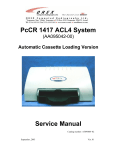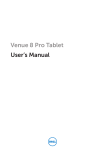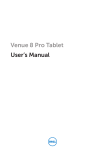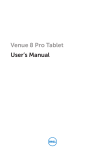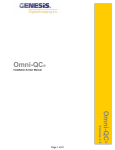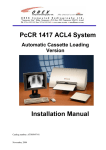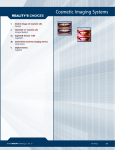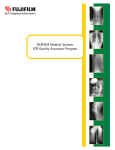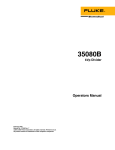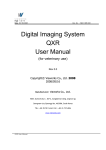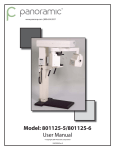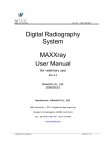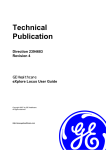Download PcCR 1417 ACL4 System - Genesis Digital Imaging
Transcript
PcCR 1417ACL4 System USER MANUAL PcCR 1417ACL4 System Users Guide Copyright © Orex Ltd 2004. All rights reserved. No part of this publication may be reproduced in any material form (including photocopying, or storing it in any medium by electronic means whether or not transiently or incidentally to some other use of this publication) without the prior written permission of the copyright owner, or under the terms of a license issued by the copyright owner. The information contained in this document is subject to change without notice. Orex is neither responsible for nor liable to anyone in connection with this document. Contact Information: Israel Headquarters: Tel: ++972-4-959-1331 Fax: ++972-4-959-1262 E-mail: [email protected] US Office: Tel: ++1-617-244-9000 Toll free: 1-888-844-7775 (within US only) Fax: ++1-617-244-9020 E-mail: [email protected] USER MANUAL c/n :AT095004-04 I Table of Contents CHAPTER 1 INTRODUCTION ......................................................................................................... 1 ABOUT OREX .......................................................................................................................................... 1 DOCUMENT CONVENTIONS ..................................................................................................................... 1 Notes and Cautions............................................................................................................................ 1 LIST OF ABBREVIATIONS ......................................................................................................................... 2 CHAPTER 2 SAFETY AND REGULATORY INFORMATION................................................... 3 GENERAL SAFETY GUIDELINES ............................................................................................................... 3 ELECTRICAL HAZARDS ........................................................................................................................... 4 EXPLOSION AND IMPLOSION HAZARDS ................................................................................................... 5 OVERHEATING ........................................................................................................................................ 5 LASER SAFETY INSTRUCTIONS ................................................................................................................ 5 LABELING SUMMARY .............................................................................................................................. 6 IEC SYMBOLS USED ............................................................................................................................... 6 DEVICE SPECIFIC SAFETY INFORMATION ................................................................................................ 7 REGULATORY INFORMATION .................................................................................................................. 7 CE Conformity................................................................................................................................... 7 USA Regulations................................................................................................................................ 8 CHAPTER 3 OVERVIEW................................................................................................................... 9 OPERATIONAL PRINCIPLES ...................................................................................................................... 9 SCANNER COMPONENTS........................................................................................................................ 10 SCANNER STATUS INDICATORS ............................................................................................................. 11 THE SCANNER INTERFACE .................................................................................................................... 12 CHAPTER 4 PERFORMING A SCAN............................................................................................. 13 LAUNCHING THE SCANNER INTERFACE ................................................................................................. 15 LOADING A CASSETTE........................................................................................................................... 15 SCANNING ............................................................................................................................................. 17 SCANNING MODES ................................................................................................................................ 19 Single Image .................................................................................................................................... 19 Multi Images.................................................................................................................................... 19 RAIS2............................................................................................................................................... 21 OSTEOGRAM® ...................................................................................................................................... 22 LONG-BONE .......................................................................................................................................... 22 Q VALUE ............................................................................................................................................... 23 SETTING UP THE SCANNER .................................................................................................................... 23 RESTORING A CORRUPTED IMAGE......................................................................................................... 25 CHAPTER 5 SETTING UP THE SYTEM........................................................................................ 29 ENTERING THE SETUP MENU................................................................................................................. 29 ADJUSTING THE SYSTEM TO AN X-RAY UNIT ........................................................................................ 30 Filters .............................................................................................................................................. 31 II Adjusting the Gain........................................................................................................................... 33 Adding and Deleting Sub Organs.................................................................................................... 36 CALIBRATION FUNCTIONS .................................................................................................................... 37 ERASING OPTIONS AND AUTOMATIC SCAN .......................................................................................... 38 Setting Erasing Options and Auto Scan .......................................................................................... 39 SETTING IMAGE PROPERTIES ................................................................................................................ 40 Data Correction Method ................................................................................................................. 40 Raw Image Properties..................................................................................................................... 40 Cropping ......................................................................................................................................... 40 Demo Scan ...................................................................................................................................... 41 JPG Image Properties..................................................................................................................... 41 Rotate Canvas ................................................................................................................................. 41 ABOUT TAB .......................................................................................................................................... 42 CHAPTER 6 CLEANING THE ROLLERS ..................................................................................... 43 OVERVIEW ............................................................................................................................................ 43 USING THE CLEANING PLATE TO CLEAN THE ROLLERS ........................................................................ 43 CHAPTER 7 SYSTEM SPECIFICATIONS..................................................................................... 47 APPENDIX A CALIBRATION PROCEDURES............................................................................. 49 FIND ORIGIN CALIBRATION .................................................................................................................. 49 OFFSET CALIBRATION .......................................................................................................................... 51 NOMINAL (FACTORY) GAIN CALIBRATION ........................................................................................... 52 Introduction..................................................................................................................................... 52 Preliminary x-ray Requirements ..................................................................................................... 52 Accessories...................................................................................................................................... 53 Calibration Procedure .................................................................................................................... 53 CR Plate Exposure and Calibration................................................................................................ 54 III Table of Figures FIGURE 1: FRONT VIEW OF SCANNER ........................................................................................................ 10 FIGURE 2: REAR VIEW OF SCANNER .......................................................................................................... 10 FIGURE 3: SCANNER INTERFACE ................................................................................................................ 12 FIGURE 4: LOADING THE CASSETTE ........................................................................................................... 16 FIGURE 5: IMAGE PREVIEW DURING SCAN ................................................................................................ 18 FIGURE 6: EXAMPLE OF MULTIPLE IMAGES ............................................................................................... 20 FIGURE 7: RAIS2 INTERFACE .................................................................................................................... 21 FIGURE 8: Q VALUE IN IMAGE HEADER ..................................................................................................... 23 FIGURE 9: CHOOSING AN IMAGE TO RESTORE............................................................................................ 25 FIGURE 10: TWIN IMAGES DISPLAYED FOR COMPARISON ......................................................................... 27 FIGURE 11: THE ENTER SETUP DIALOG BOX ............................................................................................. 29 FIGURE 12: THE SETUP DIALOG BOX ......................................................................................................... 30 FIGURE 13: UNIT SELECTION ..................................................................................................................... 31 FIGURE 14: THE IMAGE DIAGNOSTICS SCREEN .......................................................................................... 32 FIGURE 15: TWIN IMAGES DISPLAYED FOR FILTER COMPARISON ............................................................. 33 FIGURE 16: ADJUSTING THE GAIN.............................................................................................................. 35 FIGURE 17: PREVIEWING THE EFFECT OF CHANGING GAIN ON THE HISTOGRAM ....................................... 35 FIGURE 18: ADDING/DELETING A SUB ORGAN .......................................................................................... 36 FIGURE 19: THE CALIBRATION TAB ........................................................................................................... 37 FIGURE 20: THE CONFIGURATION TAB ...................................................................................................... 38 FIGURE 21: THE IMAGE TAB ...................................................................................................................... 40 FIGURE 22: THE ABOUT TAB ..................................................................................................................... 42 FIGURE 23: REMOVING THE PROTECTIVE SHEET ....................................................................................... 44 FIGURE 24: REMOVING THE PROTECTIVE PAPER STRIPS ............................................................................ 44 FIGURE 25: INSERTING THE CLEANING TRAY ............................................................................................ 45 FIGURE 26: DISCONNECTING THE CLEANING TRAY ................................................................................... 45 FIGURE 27: FIND ORIGIN CALIBRATION ..................................................................................................... 50 FIGURE 28: FIND OFFSET CALIBRATION .................................................................................................... 51 FIGURE 29: CALIBRATION SETUP ............................................................................................................... 53 FIGURE 30: FACTORY GAIN CALIBRATION ................................................................................................ 55 Chapter 1 CHAPTER 1 Introduction INTRODUCTION About Orex OREX Ltd. is a market innovator in the field of portable Computed Radiography Technologies. Founded in 1995 under the name of Digident, the company initially entered the market of desktop dental radiography providing high quality, portable CR reading units for dental and orthodontic professionals around the world. Following the successful penetration of the global dental market, the company changed its name from Digident to OREX and expanded its markets and product lines to serve the dental, medical, military, industrial and veterinary fields. OREX designs, manufactures and markets phosphor image laser scanners. These units replace the traditional x-ray film and light box. The scanners allow the user to immediately read the x-ray image from the phosphor plate, and transfer it to a DICOM 3 compatible digital computer file. Once transferred, users can manipulate the digital image for optimal viewing of details, including window-level, zoom, rotation, and measurements. Alternatively, the image can be transmitted it for long-distance consultation. After each scan, the phosphor plates are automatically erased by the unit, ready for re-use. OREX provides clients with a full solution including laser scanners, phosphor image plates, laser scanners, software for image processing, storage, retrieval and communication in Picture Archiving and Communications System (PACS) compatible format. Document Conventions Notes and Cautions Pay particular attention at specific points in a procedure when one of the following messages appears: WARNING: ! Warnings indicate precautions and instructions which, if not followed, may result in personal injury or even death. Orex Ltd 1 PcCR 1417ACL4 System Users Guide 2 CAUTION: Cautions indicate instructions that if not followed may result in damage to the software or sub optimal results. NOTE: Notes provide pertinent information to help obtain optimum performance from the software. List of Abbreviations LED – Light Emitting Diode USB – Universal Serial Bus GUI – Graphic User Interface DICOM – Digital Imaging and Communications in Medicine Chapter 2 Safety and Regulatory Information 3 CHAPTER 2 SAFETY AND REGULATORY INFORMATION General Safety Guidelines • This product was designed and manufactured to ensure maximum safety of operation. It shall be operated and maintained in strict compliance with the safety precautions, warnings and operating instructions contained herein. • The product has been designed to meet all the safety requirements applicable to medical equipment. However, anyone attempting to operate the system must be fully aware of potential safety hazards. • There are no user serviceable parts in this system. The product shall be installed, maintained and serviced by qualified service personnel according to procedures and preventive maintenance schedules laid down in the product service manual. If your product does not operate as expected, please contact your Device Service Representative. • The product in whole or in part shall not be modified in any way without prior written approval from Orex Ltd. • The product is intended for use only by personnel trained in the proper use of the system. Before using this device, the operator must be thoroughly familiar with the operator instructions and safety precautions listed here and throughout the manual. • The owner shall make certain that only properly trained, fully qualified personnel are authorized to operate the equipment. An authorized operators list should be maintained. • It is important that this manual shall be kept at hand, studied carefully and reviewed periodically by the authorized operators. • The manufacturer or vendor of the equipment makes no representation, however, that the act of reading this manual renders the reader qualified to operate, test or calibrate the system. • Unauthorized personnel shall not be allowed access to the system. • If the product does not operate properly or if it fails to respond to the controls as described in this manual, the operator shall: Orex Ltd PcCR 1417ACL4 System Users Guide 4 o Follow the safety precautions as specified in this manual. o Freeze the situation and prevent any change. o Immediately contact the service office, report the problem and await further instructions. • The images provided by this system are intended as tools for the competent user. They are explicitly not to be regarded as a sole incontrovertible basis for clinical diagnosis. Users are encouraged to study the literature and reach their own professional conclusions regarding the clinical utility of the system. • The user shall be aware of the product specifications and of system accuracy and stability limitations. These limitations must be considered before making any decision based on quantitative values. In case of doubt, please consult your sales representative. Electrical Hazards ! Do not remove or open system covers or plugs. Internal circuits use high voltage capable of causing serious injury. An electrical hazard may exist if any light, monitor or visual indicator stays on after the system is turned off. To prevent possible injury, turn off the switch in the mains power supply box on the wall and contact your service representative immediately. Fuses blown within 36 hours of being replaced may indicate malfunctioning electrical circuits within the system. Have the system checked by qualified service personnel. Do not attempt to replace any fuse. Conductive fluids that seep into the active circuit components of the system may cause short circuits that can result in electrical fires. Therefore, do not place any liquid or food on any part of the system. To avoid electrical shocks or burns caused by the use of wrong type of fire extinguisher, make sure your fire extinguisher has been approved for use on electrical fires. Chapter 2 Safety and Regulatory Information 5 Explosion and Implosion Hazards ! Do not operate the equipment in the presence of explosive liquids, vapors or gases. Do not plug in or turn on the system if hazardous substances are detected in the environment. If these substances are detected after the system has been turned on, do not attempt to turn off the unit or unplug it. Evacuate and ventilate the area before turning off the system. Overheating Do not block the ventilation ports of the electronic equipment. Always maintain at least 6 inches (12 cm) clearance around the ventilation ports to prevent overheating and damage to the electronic. Laser Safety Instructions During normal operation, to prevent the outside area from being exposed to laser emission, the scanner shall always be enclosed in its protective over. During normal operation, the cover shall not be removed. Removing the cover shall only be done for service purposes by a qualified technician. Orex Ltd PcCR 1417ACL4 System Users Guide 6 Labeling Summary SAFETY LABELS CONSIGNES DE SECURITE LASER Laser emitting product CLASS 3B LASER PRODUCT INSIDE SCANNER LASER APPAREIL ÉMETTANT DE LASER RAYONNEMENT DE LASER ÉVITEZ L'EXPOSITION AU FAISCEAU LASER DE LA CLASSE 3B APPAREIL A LASER DE CLASSE 3B À L'INTÉRIEUR DU SCANNER HIGH VOLTAGE HAUT VOLTAGE CHASSIS GROUND STUD POINT DE MISE EN TERRE DU CHASSIS ATTENTION CONSULT ACCOMPANYING DOCUMENTS ATTENTION, CONSULTER LES DOCUMENTS JOINTS IEC Symbols Used The system may have labels with one or more of the following symbols. These symbols indicate the IEC standards to which the system conforms. Alternating current Output Power Protective earth points Type B Equipment Power ON Functional Earth Ground Power OFF Warning, Caution – consult accompanying documents Input Power Caution – Electrical shock hazard Chapter 2 Safety and Regulatory Information 7 Device Specific Safety Information SAFETY INFORMATION CONSIGNES DE SÉCURITÉ LIFTING HAZARD DANGER POIDS LOURD The PcCR 1417 scanner weighs 40 Kg (88lb). Do not try to lift the scanner by yourself. Always seek assistance from another person. Lifting equipment that is too heavy may result in serious injury to personnel and/or damage to equipment. WARNING Le scanner PcCR 1417 pèse 40 kg (88lb). N’essayez pas de porter le scanner par vous-même. Demandez toujours de l’aide d’une autre personne. Porter un équipement trop lourd peut provoquer des dommages physiques et/ou endommager le matériel. ATTENTION The PcCR 1417 scanner is a CLASS 1 Laser product. Le scanner PcCR 1417 est un produit laser de la Classe 1. • Do not remove the scanner cover! • Ne pas retirer le couvercle du scanner • Cover removal shall be done only by authorized service personnel! • Le retrait du couvercle doit s’effectuer uniquement par un personnel compétent Regulatory Information The Product conforms to the following safety standards: IEC 601–1 Medical Electrical Equipment General Requirements for Safety, EN60601–1–2 Medical Electrical Equipment Electro-Magnetic Compatibility Requirements and Tests, IEC 60825-1 Safety of Laser Products CE Conformity This product conforms to the requirements of council directive 93/42/EEC. The PcCR 1417 is a Class I medical device. The PcCR 1417 bears the following mark of . The name and address of the CE representative appears on the back conformity: of the front page of this manual. Orex Ltd PcCR 1417ACL4 System Users Guide 8 USA Regulations The system was cleared for sale in the USA by the FDA. Caution: Federal US law restricts this device for sale by or on the order of a physician. Chapter 3 CHAPTER 3 Overview OVERVIEW The OREX PcCR 1417 system is designed for the reading of phosphor x-ray plates (CR) by medical professionals. The system consists of the OREX PcCR 1417 scanner and the PcCR 1417 software package that includes: • The OREX Scanner Interface software that operates the scanner. • An image viewing and archiving software package that supports the DICOM 3.1 standard and was approved by OREX, such as Or-Acquire. The system features: • 8"x10"; 10"x12"; 14"x17"; 9.5"x9.5" digital image reading and viewing archive (18x24 and 24x30 are optional for mammography; 14”x34” cassette is optional for the long-bone application). • Cassette formats include: • o General radiology scans o Osteogram® scans o Long-bone scans (for long cassettes) Plug and Play USB interface. Operational Principles The PcCR 1417 is a digital imaging system for image acquisition and processing of static projection radiography that uses a phosphor plate with energy storage capability as an xray image receptor. After exposure, a laser beam, which stimulates luminescence proportional to the local xray exposure, reads the plate. The luminescence signal is digitized. The data is then subjected to digital image processing. The OREX PcCR 1417 scanner enables the user to read a plate quickly, and erase it to be ready for the next read. The scanner is compact and easy to use. Using the PcCR 1417 system enables medical professionals to “go digital” without changing their work practices or x-ray equipment. Orex Ltd 9 PcCR 1417ACL4 System Users Guide 10 Scanner Components The Scanner consists of the following components: Cassette Tray Scanner Status LEDs Figure 1: Front View of Scanner USB Connector ON/OFF Switch Power Connector Figure 2: Rear View of Scanner Chapter 3 Overview 11 Scanner Status Indicators There are two LED status indicators located on the front of the PcCR-1417 scanner, above the cassette entry slot. Each indicator can appear Green and Orange, and the color can be either constant or blinking. The colors indicate the following: System Status Left LED Right LED Power Up Orange Off Power Up (FW downloading done) Off Green Insert Plate Green Blinking Green Blinking Loading Cassette/Plate Green Blinking Green Blinking Ready For Scan Green Blinking Green Scanning Green Green Saving Image and Erasing Orange Blinking Green Blinking Unloading Cassette/Plate Green Blinking Green Blinking Pull Out Cassette Green Blinking Green Blinking Error Orange Blinking Orange Blinking Orex Ltd PcCR 1417ACL4 System Users Guide 12 The Scanner Interface 9 8 1 2 3 4 5 6 Figure 3: Scanner Interface 1 Scan 2 Abort 3 Erase 4 Unload plate and Eject cassette 5 Restore files from archive 6 Setup 7 Exit 8 Body part selection 9 Units 7 Chapter 4 CHAPTER 4 Performing a Scan 13 PERFORMING A SCAN The scanning process consists of the following stages: • Launching the Scanner Interface Software • Loading a Cassette • Scanning and Erasing a Plate Orex Ltd 14 PcCR 1417ACL4 System Users Guide The flowchart presents the process in a graphic form: Chapter 4 Performing a Scan 15 Launching the Scanner Interface 1. Switch ON the scanner Power Switch (See Figure 2). 2. Wait for the warm-up process to complete (can take up to three minutes). 3. Switch on the computer 4. Open the viewer interface 5. Create a new patient file, or select an existing patient file. When the patient file is opened the scanner interface will automatically open. 6. Select the unit corresponding to your x-ray settings. 7. Select the body area (organ and sub-organ) corresponding to the image on the plate 8. The scanner starts communicating with the computer. Within a few seconds, check that the scanner SYSTEM LED turns green (See Figure 4), and the Insert plate message is displayed on the main dialog. 9. Load the cassette as described in the following section Loading a Cassette The image plate is contained within the cassette. The only time that the plate should be out of the cassette is when the scanner automatically loads it for reading. 1. Verify that the scanner is On, and that the System LED is green, indicating that the scanner is ready. 2. Insert the cassette into the scanner making sure that: • The blank side faces up • The open edge points toward the scanner, and • The cassette is exactly centered in the scanner slot. Orex Ltd PcCR 1417ACL4 System Users Guide 16 Figure 4: Loading the Cassette 3. Slightly push the cassette into the scanner (Figure 4) until it locks into position, and the PROCESS LED turns orange and starts blinking. 4. The plate is automatically "pulled" and loaded into the scanner. 5. The PROCESS indication LED changes from orange to green. 6. The Scanner is now in the correct condition to scan the loaded plate. The Plate “width” x “length” is ready... message is displayed on the main dialog. At this point, you can choose to perform any of the following actions: • Select the anatomical area relevant to the image and scan the loaded plate. • Unload the plate by clicking Eject. • Erase the loaded plate by clicking Erase. • Cancel and close the Scanner Interface by clicking Exit. If no scanning is performed within two minutes, the cassette is automatically ejected. Chapter 4 Performing a Scan 17 Scanning Caution: While scanning, do not perform any other operation on your computer (for example, printing, network operation, or emailing). These operations may result in errors in the scanning process. 1. Click the Scan button to initiate scanning. The Initializing scanning, and then the Scanning messages are displayed on the main dialog. 2. If you want to stop the reading process, click the Abort button. The plate is automatically unloaded from the Scanner into the cassette. Note: If you press the Abort button the cassette is not erased. You must manually erase the cassette before the next exposure. • You can view the scanned image in the Image Preview window (Note that the image brightness and contrast change as the scanning proceeds). • A countdown timer is displayed on the lower right indicating the time left for reading the plate (Figure 5). Orex Ltd PcCR 1417ACL4 System Users Guide 18 Countdown Timer Figure 5: Image Preview During Scan When the scanner has finished reading the plate, the digital image appears in the Preview Window. • Unless otherwise selected, the cassette will be erased automatically, and an Erase message appears. • If Auto erase was not pre-selected, and you wish to manually erase the cassette, insert the cassette, and wait for system initialization to be completed. When the Plate “width” x “length” is ready... message is displayed on the main dialog, press the Erase button. A countdown timer is displayed only in the non-automatic erasing mode. Depending on the scanning mode (See Scanning Modes, page 19), the image is either automatically sent to the QC station, or is sent to the QC station together with additional images from the study. You have completed the plate scanning process. At this point you can re-use the scanned and erased plate Chapter 4 Performing a Scan 19 Scanning Modes When the system is installed, the technician sets which scanning modes are available. The system offers three scanning modes: • Single image • Multi image • RAIS2 The user cannot change the available scanning modes. If you wish to change the available modes, contact your Orex-authorized distributor. Single Image In the single image mode, the image is automatically sent to the QC station immediately after scanning. This mode should be used if you do not perform studies or scan images from two scanners simultaneously. Multi Images The multiple images feature is useful when performing a study. This feature allows scanning of multiple images from the same patient without having to exit and reenter the interface. Orex Ltd PcCR 1417ACL4 System Users Guide 20 Scanned images in the series Figure 6: Example of Multiple Images To scan in the multi image mode, scan a series of cassettes without clicking the Exit button. The last ten images of the series appear in a row under the preview screen. • Click the image to enlarge it. • To flip or rotate the image, right click on the image. A popup menu will appear. • After you have scanned the last image in the series, click the Exit button to send the images to the QC station. Chapter 4 Performing a Scan 21 RAIS2 RAIS2 is for use with two Scanners. In RAIS2 mode you can save time by scanning multiple images from the same patient simultaneously, using two different Scanners. Figure 7: RAIS2 Interface The image from each Scanner appears in a preview window, and then appears in a row under the preview window. • Click the image to enlarge it. • To flip or rotate the image, right click on the image. A popup menu will appear. • After you have scanned the last image in the series, click the Exit button in the lower right corner to send the images to the QC station. Orex Ltd PcCR 1417ACL4 System Users Guide 22 Osteogram® Osteogram is an optional feature that can produce images that are compatible for use with Osteogram® software. For further details see the Osteogram User Guide Long-Bone Long-bone is an optional application for use in cases where long images are required such as scoliosis. For further information see the Long-Bone user-guide. Chapter 4 Performing a Scan 23 Q Value The Q value provides a quantitative indication of image quality. The Q value appears in the header of the image in the QC station (Figure 8). This parameter is an exposure index that is attached to the image header and displayed on the upper right side of the image. The Q-number is based on an image-processing module that performs histogram analysis to deduce the radiography exposure conditions. The Q-number serves as an indicator for the dose in the plate and for image quality, and indicates either extreme under or over exposure. The optimal range for the various body parts depends on the x-ray techniques that are used at the specific clinics. The Q-number is factory-calibrated to 10uGy dose (80KV, 5mAs, 1-mm Cu filtration, SID~1.25m). When a flat-field image is processed at ‘no-correction’ mode and at PMG’=100, one should expect to receive Qcal=200 at tolerance of ±10%. Typical values for producing properly-expose images are within a range of 100-400 (For extremities 100-600), where this value is linearly proportional to the dose on the plate. The higher Q value - the higher dose on the plate. Q Value Figure 8: Q Value in Image Header Setting up the Scanner You must set the system parameters when at first time you either you use the system or scan specific organ. Once the system/organ scan parameters were set, it is not required to set the system parameters for the next scans. See Chapter 5 for further details. Orex Ltd PcCR 1417ACL4 System Users Guide 24 Click the Setup button to open the Setup window. The Setup window contains several menus (tabs) to set the parameters for system operation: • Anatomical – Use to adjust the parameters linked to the anatomical regions to be scanned and specific parameters related to these scans, including specific gain and image enhancement tools (filters). • Calibration – Initiates system calibration procedures. These procedures are performed during production and the user it is not allowed to conduct them. • Image – This tab is used to set data correction methods and other general (not anatomical specific) image enhancement tools including automatic rotation/flip of images. • Configuration – Use to adjust technical data connected to image acquisition and scanner interface such as plate origin adjustment, possibility to evoke special menus like image restore. Chapter 4 Performing a Scan 25 Restoring a Corrupted Image Selection of incorrect image enhancement tools (filters) can result in a sub-optimal image, in spite of the fact that the raw data of the image (x-ray dose and corresponding Gain) is optimal. If you suspect that this situation occurs for one or more images, you can restore the image in its raw state, and process it manually, with the tools available in the Image Diagnostics application. Figure 9: Choosing an Image to Restore 1. If the Restore button is not visible in the interface, at Configuration tab (see previous section), select the Show Restore Button checkbox; then click Save and OK. The Restore button now is displayed in the Main menu. 2. Click the Restore button on the Scanner Interface. The contents of the Archive directory are displayed. 3. You can select the image to be restored according the date and time of the scan. For reasons of confidentiality, the patient’s name is not displayed in the image archive. After choosing the desired image from the Archive directory, click Open. The image is displayed in the Image Diagnostics screen. Orex Ltd 26 PcCR 1417ACL4 System Users Guide The following image enhancement tools (Table 1) are available to produce an optimal image. Display image Histogram in gray-scale dimension Zoom In Zoom Out Flip Horizontal Pan Rotate 90 Left Rotate 90 Right Designate Region of interest for Histogram Exit Table 1: Image Enhancement Tools To compare the use of the different tools, you can open multiple copies of the image by clicking the following buttons: Show single image Show double image Show quadruple image and try a different tool or combination of tools on each (Figure 10). Chapter 4 Performing a Scan 27 Figure 10: Twin Images Displayed For Comparison When the image appearance and quality satisfy you (the viewer), you can save the present setup by clicking the Save setup to anatomy bar. To exit the Image Diagnostic screen click the Exit button. The image will be saved in the database. Note: Uncheck the Show Restore Button box in the Configuration tab if you do not wish the Show Restore button to appear in the interface. Orex Ltd Chapter 5 CHAPTER 5 Setting Up the Sytem 29 SETTING UP THE SYTEM Entering the Setup Menu Not all set up functions are available to the user. Functions that are available to the technician only appear grayed out when a user enters the set up functions. 1. From the main interface, click the Setup button dialog box opens: (Figure 11). . The Enter Setup Figure 11: The Enter Setup Dialog Box 2. Choose User. 3. Click OK. The Setup dialog box opens with the Anatomical tab selected (Figure 12). Orex Ltd 30 PcCR 1417ACL4 System Users Guide Figure 12: The Setup Dialog Box Adjusting the System to an X-ray Unit The Scanner Interface is designed to work with up to four different x-ray units. A unit can be assigned to different X-ray machines (e.g., mobile and stationary) or to widely different x-ray settings (e.g., premature babies and pregnant women in a maternity wing) on the same unit. Each unit is represented by a number, and includes a unique set of PM Gain (and offset) values, and filtration values for each sub-organ. Before x-raying, select the machine you are going to use by clicking that unit’s number. Each unit can be given a name on the Anatomical tab. After you name a unit, that name appears on the main dialog whenever that unit is activated To adjust the system to an x-ray unit: 1. In the Scanner Interface (Figure 13) click the desired unit (1, 2, 3, or 4). This can also be done on the Anatomical tab of the Setup dialog. Chapter 5 Setting Up the Sytem 31 Click here to select a unit Figure 13: Unit Selection 2. Once inside a specific unit, you can select the Gain and the Image enhancement filter for each organ Filters Selecting an organ automatically evokes a recommended (default) image enhancement filter. If the default filter does not turn out to be suitable for the sub-organ, you can select a different filter from the pull-down list (which is common to all the sub-organs creating an organ) and click the Set button. If you choose not to use an image enhancement filter for that specific sub-organ, select the None option. Selecting a Filter To select a filter: 1. Click Adjust Filter to Organ button in the upper right corner. 2. The Image Diagnostics screen opens (Figure 14): Orex Ltd 32 PcCR 1417ACL4 System Users Guide Choose Filter Figure 14: The Image Diagnostics Screen To compare the use of the different filters, you can open multiply copies of the image by clicking the following buttons: Show single image Show double image Show quadruple image and try a different tool or combination of tools on each (Figure 15). Chapter 5 Setting Up the Sytem 33 Figure 15: Twin Images Displayed For Filter Comparison 1. Choose a filter from the dropdown list (Figure 14) and click the process on the image. button to see its affect 2. Choose Default to reset the zoom, windowing, data correction, and filters and to restore the original image state. 3. Choose Save Setup in Anatomy to save the filter, data correction method and gain to the specific organ. (For information about setting the gain, see Adjusting the Gain, page 33) Adjusting the Gain The PM Gain used during the scan of a specific image controls the image quality. The PM Gain should be calibrated so that the image histogram falls within the dynamic Orex Ltd PcCR 1417ACL4 System Users Guide 34 range so as to prevent under or over exposure states. Its effect is similar to adjusting the processing time in non-automatic film developers. Once changed, the new PM Gain setting affects the results of scanned images in the relevant unit only when that same sub-organ is selected. There are two methods for tuning the reader PM gain: • Manually in the Anatomical tab • Using Histogram simulation in the Diagnostics screen Changing the Gain in the Anatomical Tab To change a PM Gain value in the Anatomical tab (See Figure 16): 1. From the Organ drop-down list, select an organ (unless an organ has already been selected in the main dialog). 2. From the Sub Organ drop-down list, select the sub-organ image for which you would like to change the PM Gain (unless the sub-organ has already been selected in the main dialog). 3. Click the Gain drop- down list. Change/adjust the Sub-Organ PM Gain (in the Sub organ acquisition setup section): • To get a darker image (in case of under exposure), increase the Sub Organ PM Gain. • To get a lighter image (in case of over exposure), decrease the Sub Organ PM Gain. 4. Click Save 5. Click OK to return to the Scanner Interface’s main dialog. Chapter 5 Setting Up the Sytem 35 Figure 16: Adjusting the Gain Changing the PM Gain in the Image Diagnostics mode To give you an idea of how changing the gain will affect the histogram you can enter a PM gain value in the Diagnostics screen and immediately see how the histogram is affected, before saving the value. For instance, in Figure 17A the gain is set to 1.0 producing a sub-optimal histogram that is too close to the origin. In Figure 17B the gain has been changed to 0.3, and the histogram moves to a more optimal position towards the middle of the graph. B A Figure 17: Previewing the Effect of Changing Gain on the Histogram To change the Gain Factor, enter a value in the Gain Factor window, and then click Process. Orex Ltd PcCR 1417ACL4 System Users Guide 36 After observing the effect of changing the Gain Factor on the histogram and image, you have two options for saving the gain factor: • Save Gain Factor to Anatomy saves the Gain Factor for the specific organ. • Save Gain Factor Globally saves the Gain factor for the whole unit. Adding and Deleting Sub Organs When you add/delete sub-organs, changes are automatically saved in all units. To add a new sub-organ (See Figure 18): 1. Select the relevant organ in the Organ column. 2. Insert the new sub-organ in the Set New Sub Organ Name field. 3. Click the Add new sub-organ button. 1 2 3 Figure 18: Adding/Deleting a Sub Organ To delete a sub-organ, select it and click the Delete sub-organ button. Chapter 5 Setting Up the Sytem 37 Calibration Functions The PcCR system is leaves OREX factory port calibrated through the three calibration stages: Origin, Offset and PM gain. Any of these calibrations stages should be performed only by OREX representative (support or authorize distributor) . For further details see Appendix A Calibration Procedures, page 49. The origin calibration step finds the system origin coordinates (x,y) to be used during the scan. The offset calibration step generates the table of dark current values (offset) at each PM gain value to be compensated during a normal scan. The Factory Gain Calibration step map the system response. At each gain value – the average pixel value is measured. A table of PM gain values is constructed and used during the anatomical adjustment and specific clinic tuning. Figure 19: The Calibration Tab Orex Ltd PcCR 1417ACL4 System Users Guide 38 Erasing Options and Automatic Scan Figure 20: The Configuration Tab The Configuration tab allows the user to set a number of options. Caution: Most of these functions should not be altered without first conferring with an authorized Orex representative • Erase factor enables you to change the default erase time. Over 100% sets a longer time. • Auto erase after scan enables the erasing of a plate automatically after the scan is completed. Auto erase after scan is the default value of the system and should be changed only specific conditions. Note: When auto erase is disabled, the cassette needs to be manually erased after each scan. Otherwise, images acquired might not be of clinical value. Chapter 5 Setting Up the Sytem 39 • Auto scan enables the initiation of a scanning procedure as soon as the cassette enters the scanner. This option is useful if you are continually imaging the same sub organ. By choosing this option you don’t have to use the interface to initiate scanning. • Rescan enables an additional scan on the same plate without reloading the plate. • Show Restore Button displays the Restore button at the bottom of the main screen, enabling you to display raw images in case the one you want to modify any of the image enhancement tools used by Orex (e.g., image-enhancement filters, noise reduction, automatic image crop) • Auto Load initiates plate loading as soon as the cassette is inserted; then reloads it after it is scanned and unloaded. For Scanner diagnostics only. This option is usually not recommended for clinical purposes, since additional images are not associated with a patient or an organ. • Warming up Override enables you to start scanning operation immediately, without waiting for the Erase Lamps to warm up. This option is intended for scanner diagnostics mode only. Caution Scanning with this option enabled may result in sub optimal images. Setting Erasing Options and Auto Scan 1. For optimal erasing, use the following Erase factors, and Save. This procedure should be performed by an OREX technician or upon instructions from OREX: • For ACL4: o Agfa 8 x 10 film: 60 o Agfa 14 x 17 film: 60 Orex Ltd PcCR 1417ACL4 System Users Guide 40 Setting Image Properties Figure 21: The Image Tab Data Correction Method The general work mode for Data Correction is Linearization. In some cases, such as during system tests or when a raw data it required, the No-Correction mode is selected. It is not recommended to change the data correction mode without consulting with Orexauthorized support. Raw Image Properties If an image fails to appear on your viewer, it is important to make sure that the image’s “Raw image path” in your viewer matches the location on your hard disk (contact OREX support for the location on the hard disk). • The image path determines how the image is entered into the PACS • Uncheck the Include Header box if your PACS does not support headers. Cropping Use this function to crop out white areas around the image. Chapter 5 Setting Up the Sytem 41 • Auto crop automatically removes the white areas around a scanned image, according to image content • Geometric Crop removes a specific amount pre-selected (by Orex) amount of the white area around a scanned image Demo Scan The Demo Scan function enables you to display an image on your computer screen without connecting to the scanner. To use the Demo scan function select the Demo Scan box. JPG Image Properties The system can store up to 500 images in jpg format. Use the fields in this box to determine the number of images to be stored, where they will be stored, and how much compression will be used. Rotate Canvas This function determines the orientation of the image produced. It enables you to rotate an image in a constant manner for all images acquired Orex Ltd PcCR 1417ACL4 System Users Guide 42 About Tab The About OREX Software tab (Figure 22) lists the versions of system’s software (Boot, Scanner Interface, and so on). Knowing which versions you have may be necessary when you contact a technician or support personnel by phone or email. You can also view the number of scans that have been performed by your Scanner since the last reset. The Serial Number of the Scanner is also listed here. Figure 22: The About Tab Chapter 6 Cleaning the Rollers 43 CHAPTER 6 ROLLERS CLEANING THE Overview Periodically clean the rollers to remove dust and small particles. The roller-cleaning device enables you to clean the rollers that feed the image plate from the cassette into the Scanner. The Cleaning device includes the following items: • Cleaning tray • Cleaning plate with adhesive strips covered with protective paper/a protective envelope. Using the Cleaning Plate to Clean the Rollers 1. Remove the cassette and plates form the Scanner. 2. Open the Scanner Interface. 3. In the Scanner Interface, click the Setup button. The Setup dialog box opens. 4. In the Setup dialog box, select the Configuration tab. 5. Click the Prepare button in the Scanner cleaning box located in the lower left corner of the Configuration tab. 6. When prompted, click OK, and immediately shutdown the Scanner. 7. Attach the cleaning tray to the Scanner. Push it in until it locks. 8. Remove the transparent protective sheet/protective envelope from the cleaning plate (Figure 23). Orex Ltd PcCR 1417ACL4 System Users Guide 44 Figure 23: Removing the Protective Sheet 9. Remove the protective paper strips from the cleaning plate to expose the adhesive (Figure 24). Figure 24: Removing the Protective Paper Strips 10. Place the cleaning plate on the tray. Make sure the cleaning plate is placed in the correct direction, as specified on the plate. Chapter 6 Cleaning the Rollers 45 Figure 25: Inserting the Cleaning Tray 11. While holding onto the plate, push the plate into the Scanner (Figure 25). It should go in almost entirely. A 10 cm segment of the plate should remain visible. Then pull the plate out. 12. Repeat step 11 three times. 13. Remove the cleaning plate from the Scanner. Disconnect the cleaning tray by pulling out the knob underneath the front tray (Figure 26). Figure 26: Disconnecting the Cleaning Tray Orex Ltd Chapter 7 System Specifications 47 CHAPTER 7 SYSTEM SPECIFICATIONS Weight: 40 kg (88 lbs) Dimensions (W x D x H) 733 x 655 x 340 mm (39” x 26” x 14”) Scanning Resolution Plate and Pixel Size 2.5 Lp/mm 5 Lp/mm 3.5 Lp/mm 4.2 Lp/mm 4.2 Lp/mm Standard format 14" x 17" High resolution 14" x 17" Normal format 10" x 12" High resolution 8" x 10" Normal format 9.5" x 9.5" 8" x 10" plate size 100 x 100 µm pixel size 9.5" x 9.5"plate size 100 x 100 µm pixel size 10" x 12" plate size 126 x 126 µm pixel size 14" x 17" plate size 173 x 173 µm pixel size (or 86 x 86 µm at high resolution) Plate Type AGFA ADC-MD-30 (produced and licensed to OREX by AGFA-GEVAERT A.G.) Scanning Time 9.5" x 9.5"plate size 8" x 10" plate size 10" x 12" plate size 14" x 17" plate size 9.5" x 9.5"plate size 8" x 10" plate size 10" x 12" plate size 14" x 17" plate size 9.5" x 9.5"plate size 8" x 10" plate size 10" x 12" plate size 14" x 17" plate size Erasing Time Total Scanning Time Orex Ltd 47 sec. 62 sec. 50 sec. 50 sec. 16 sec. 13 sec. 19 sec. 26 sec. 82 sec 92 sec. 86 sec. 90 sec. Appendix A Calibration Procedures 49 APPENDIX A CALIBRATION PROCEDURES CAUTION: These procedures should be performed only Orexauthorized representative or support. Find Origin Calibration To perform find origin calibration: 1. Make a flat field (general purpose cassette) 2. Insert the cassette containing the phosphor plate into the scanner. 3. From the Calibration tab, select the Find Origin checkbox. 4. Click Start, to start the Calibration process. The calibration scan starts from the right hand side A successful completion of the process results in a green check mark to the left side of the process icon. Orex Ltd 50 PcCR 1417ACL4 System Users Guide Figure 27: Find Origin Calibration Appendix A Calibration Procedures 51 Offset Calibration The Offset calibration automatically finds the offset values for predetermined gain values, and sets them in a Look Up Table. 1. Insert a general-purpose cassette containing the phosphor plate into the scanner. 2. Erase the phosphor plate twice (to eliminate any remainder of information on the film). 3. Start Scan 4. From the Calibration tab, select the Find Offset checkbox. 5. Click Start, to start the Calibration process. For every PM level (255 system values) the system calculates an equivalent offset value When the process is successfully completed, a green check mark will appear to the left side of the process icon, together with a table containing the new offset values. Figure 28: Find Offset Calibration Orex Ltd PcCR 1417ACL4 System Users Guide 52 Nominal (Factory) Gain Calibration Introduction This procedure is based on linearization of three parameters: the dose level of exposure (measured in µGy), the PM gain (specified as 8bit A/D value, 256 values), and gray level (12 bit A/D, 4000 system values). Usually, for a given dose level, the mean gray level (GL) of the scanned image corresponds to the PM gain used. For the same scan, increasing (decreasing) the PM gain – will increase (decrease) the signal (GL). This calibration procedure uses a new PM gain value, called PMG’, where each PMG’ refers to a specific GL with linear dependence. Preliminary x-ray Requirements 14”x17” exposed area must be verified for uniform lateral exposure level at the following doses: Application CR RT Machine ACL-4S ACL-4B ACL-4S ACL-4B Dose 2.5 - 2.8 1.25 -1.4 600-700 300-350 Units µGy µGy µGy µGy Appendix A Calibration Procedures 53 Accessories • ACL machine with Nominal Gain Calibration s/w installed • Calibrated dosimeter • Copper plate 1 mm thick • CR 14”x17” cassette: o Aluminum faceplate o With MD30 plate. Calibration Procedure Figure 29: Calibration Setup X-Ray Dose Adjustment 1. Using the X-ray machine set-up panel verify, on the monitor screen, the following parameters: Large focal spot, SID=2.05m (‘Delta’), 80kVp, and mAs as follows: Application CR RT Machine ACL-4S ACL-4B ACL-4S ACL-4B Orex Ltd 4.5 2.5 30 15 mAs (300mA; 15ms) (100mA; 20ms) (300mA; 100ms) (300mA; 50ms) PcCR 1417ACL4 System Users Guide 54 2. Slide the X-ray source head to a SID=80’’ (205 cm): move the table aside and clear the path for the X-ray beam from the source down to the floor to achieve the required SID. 3. Place the dosimeter on the floor, at the beam center. 4. Place the Copper plate at the X-ray collimator window. (For RT calibration: no-filtration is used). 5. The set-up scheme is shown in Figure 29. 6. Execute exposure and read the dosimeter readout. 7. If the dosimeter readout is out of the required range, slide the X–Ray head slightly above and below the nominal SID to achieve the required dose. 8. Remove the dosimeter detector when the dose requirement is complied. CR Plate Exposure and Calibration 1. Slide the Copper plate out of the collimator window. 2. Place the cassette, loaded with well-erased CR plate, on the floor, with its center located at the X-ray beam center. 3. Slide back the Copper plate to cover the collimator window. (For RT calibration no-filtration is used) 4. Expose the cassette setup to X-ray radiation. 5. Enter the scanner interface and click the setup button. Note that it is assumed that the origin-find and offset find calibrations were executed through the normal procedures. 6. In the calibration tab of the scanner interface, check the Find Gain box (Figure 30), and verify that the radio button CR is selected, then click Start to initiate the calibration process. Appendix A Calibration Procedures 55 Figure 30: Factory Gain Calibration 7. The progress of the calibration process can be viewed on screen at the Scanner Interface window 8. The system will inform you when it has completed the Calibration process. 9. Click OK in the calibration tab, and exit the scanner interface. Note that in scan-mode operation the PMG should be set. Enter the calibration results in the form on the following page. Orex Ltd PcCR 1417ACL4 System Users Guide 56 Calibration Process Results Machine Serial Number: Software version: Date: Tested by: Signature: X-ray Exposure Conditions: Parameter Actual Requirement 80 1. x-ray KV: 2. x-ray mAs: 3. x-ray Dose: 4. Focal Spot (Small/Large) 5. SID: 6. Cassette Identification: 7. Cassette Format: Large 205 14’’x17’’ Units KV mAs µGy cm Calibration Results Parameter Actual 1. X-Ray Dose for calibration 2. Gray level at PMG=250 Requirement 0 - 1000 Units µGy Sys. Values Verification Results Parameter 1. Upper half: mean gray level, SU 2. Bottom half: mean gray level, SB 3. Calculate: (4000-SU)/(4000-SB) Actual Requirement 2300 - 2600 3100 - 3400 1.8-2.1 Units Gray Level Gray Level -
































































